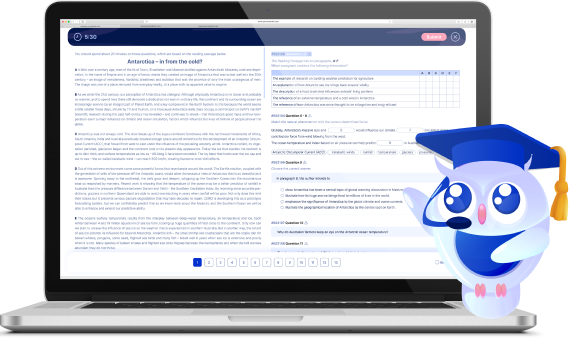Summary Completion IELTS Reading – Edmicro IELTS sẽ giới thiệu với bạn các bước chi tiết và những lưu ý khi làm bài!
Tổng quan về Summary Completion IELTS Reading
Summary Completion IELTS Reading là một dạng trong đề thi Reading, yêu cầu thí sinh điền từ vào chỗ trống trong một đoạn tóm tắt của bài đọc. Đoạn tóm tắt này thường cung cấp thông tin chính của bài đọc, bao gồm các ý chính, luận điểm, và kết luận.
- Vị trí và số câu: Thường xuất hiện ở bài đọc thứ 1 hoặc 2 trong tổng số 3 đến 4 bài trong đề thi. Chiếm số lượng câu từ 4-10 câu.
- Hình thức: Theo một đoạn văn tóm tắt hoặc theo một danh sách tóm tắt.
- Độ khó: tương đối phức tạp do đoạn tóm tắt yêu cầu thí sinh phải đọc và chọn lọc những từ phù hợp để thể hiện nội dung bài đọc.
- Thông tin cần điền: Thông tin có thể là những từ, cụm từ xuất hiện trong bài đọc hoặc cụm từ, từ trong danh sách cho trước.

Xem thêm: Thang Điểm IELTS Reading Cập Nhật Mới Nhất
4 bước làm bài Summary Completion IELTS Reading
Để làm tốt dạng này, thí sinh cần nắm vững 4 bước sau:
Bước 1: Đọc đề bài
Đọc kỹ đề bài để xác định số từ hay cụm từ được điền là bao nhiêu.
| Ví dụ minh họa | Phân tích |
| Questions 1 – 7 | Câu hỏi từ câu 1 đến câu 7 |
| Complete the summary below. | Yêu cầu hãy hoàn thành đoạn tóm tắt bên dưới. |
| Write NO MORE THAN TWO WORDS from the text for each answer. | Thí sinh chỉ được viết đáp án là 1 đến 2 từ. Nếu thí sinh viết 3 từ hoặc viết số, sẽ bị đánh là sai. |
Bước 2: Đọc các câu hỏi và dự đoán thông tin cần điền
Thí sinh cần đọc lướt qua đoạn tóm tắt để hiểu được thông tin chính của đoạn. Thí sinh không cần đọc kỹ từng câu trong đoạn. Bạn có thể đánh dấu các từ khóa chính xoay quanh câu hỏi để dự đoán từ cần tìm.
| Ví dụ minh họa | Phân tích |
| Negative environment effects have been limited and 3._____________________________ are controlled to reduce problems. | Các từ khóa cho biết đáp án cần điền là một danh từ. Danh từ này khi được kìm hãm sẽ làm giảm thiểu những vấn đề về môi trường. |
Bước 3: Lướt nhanh qua văn bản để tìm câu trả lời
Thí sinh cần so sánh đoạn văn tóm tắt với đoạn văn chính để xác định các thông tin cần điền vào các chỗ trống. Sau đó, thí sinh cần chọn từ ngữ phù hợp điền vào các chỗ trống dựa trên ý chính của đoạn văn tóm tắt và các thông tin trong đoạn văn chính.
| Ví dụ minh họa | Phân tích |
| The environment at La Rance has remained healthy, but there have been changes. The barrage has caused limited silting of the Rance ecosystem, although this has been manageable. Sand eels and plaice have reduced in numbers, but sea bass and cuttlefish have returned to the river. The tidal flows are regulated in the estuary by the operators, who adjust them to minimize the biological impact. | Ở đoạn văn thứ 8, ta xác định được những từ khóa có liên quan đến câu hỏi cần tìm. Ta xác định được qua việc tìm những từ đồng nghĩa với từ khóa: adjust – control; minimize – reduce; biological impact – environment effects. Vậy đáp án là tidal flows. |
Bước 4: Kiểm tra lại bài
Sau khi đã hoàn thành các bước trên, thí sinh cần kiểm tra lại đáp án để đảm bảo rằng đáp án là chính xác. Thí sinh hãy đảm bảo rằng đáp án của bạn phù hợp với ngữ pháp và nghĩa của đoạn văn tóm tắt và nội dung của bài đọc chính, trước khi chuyển sang phần tiếp theo.
Các lưu ý về Summary Completion IELTS Reading
| Hãy đoán nếu bạn chưa chắc chắn câu trả lời | Đừng để trống câu trả lời. Và để ý, chỉ điền đúng số từ quy định ở đề bài. |
| Luyện tập thường xuyên | Càng luyện tập nhiều, bạn càng có khả năng xác định và kết hợp thông tin tốt hơn. |
| Chú ý đến các từ khóa và cụm từ xung quanh mỗi chỗ trống | Chúng sẽ cung cấp cho bạn manh mối về loại từ hoặc cụm từ cần thiết. |
| Làm quen với dạng bài đọc IELTS này | Hiểu các loại câu hỏi, thông tin khác nhau và cách xác định chúng. |
| Quản lý thời gian | Thực hành quản lý thời gian của bạn một cách hiệu quả để hoàn thành nhiệm vụ trong thời gian quy định. Thời gian hợp lý để hoàn thành bài Summary Completion IELTS Reading là 10 phút với số lượng câu 4 – 6 câu. |

Xem thêm: Chiến Lược Làm Bài Reading IELTS Bật Band Cực Nhanh
Bài minh họa Summary Completion IELTS Reading
Tidal Energy
Tidal energy is a form of hydropower that utilizes large amounts of power within the ocean’s tides to generate electricity. Tidal energy is a renewable energy source, as the Earth uses the gravitational forces of both the moon and the sun everyday to move vast quantities of water around the oceans to produce tides.
There are different kinds of tidal power systems. A tidal barrage is a type of tidal power generation that involves the construction of a fairly low dam wall, known as a ‘barrage’, across the entrance of a tidal inlet or basin, creating a tidal reservoir. This dam has a number of underwater tunnels cut into its width allowing seawater to flow through them in a controllable way, using a sluice gate on the sea and reservoir side, which can slide down or up to release or retain water as desired. Fixed within the tunnels are propellers that are turned by the tidal flow and they in turn spin a turbine. The movement creates a magnetic field within the generator above, which is converted to electricity.
One disadvantage of tidal barrage electricity generation is that it can only generate electricity when the tide is actually flowing either in or out, as during high and low tide times the tidal water is stationary. However, as the tides are completely predictable, it is straightforward to plan how to compensate for low generation times with other providers in the energy mix. Supporters of tidal power also point out that other renewable energy resources, such as solar and wind farms, are much more unpredictable and intermittent. Other disadvantages of a tidal barrage system are the high construction costs and the environmental effects that a long concrete dam may have on the estuary it spans.
A tidal stream generation system reduces some of the environmental effects of tidal barrages by using turbine generators beneath the surface of the water. Major tidal flows and ocean currents, like the Gulf Stream, can be exploited to extract their tidal energy, using underwater rotors and turbines. Tidal stream generation is very similar in principle to wind power generation, except this time, water currents flow across a turbine’s rotor blades that rotate the turbine, much like how wind currents turn the blades for wind power turbines. In fact, tidal stream generation areas on the seabed can look just like underwater wind farms.
Unlike offshore wind power turbines, which can suffer from storms or heavy sea damage, tidal stream turbines operate just below the sea surface or are fixed to the seabed. Tidal streams are formed by the horizontal fast flowing volumes of water caused by the ebb and flow of the tide, as the profile of the seabed causes the water to speed up as it approaches the shoreline.
As water is much denser than air and has a much slower flow rate, tidal stream turbines have much smaller diameters and higher tip speed rates compared to an equivalent wind turbine. One of the disadvantages of tidal stream generation is that, as the turbines are submerged under the surface of the water, they can create hazards to navigation and shipping.
A good example of a successful tidal power project is the La Rance power station in France. This tidal barrage is still the largest tidal power station in the world, in terms of installed capacity, with a peak rating of 240 megawatts generated by its 24 turbines, and an annual output of approximately 600 gigawatts. The building expenditure was significant, even back in 1966 when it was opened, but these have now been recovered and electricity production costs are lower than that of nuclear power. The high cost of tidal barrages, however, is what has discouraged the further construction of similar projects.
The environment at La Rance has remained healthy, but there have been changes. The barrage has caused limited silting of the Rance ecosystem, although this has been manageable. Sand eels and plaice have reduced in numbers, but sea bass and cuttlefish have returned to the river. The tidal flows are regulated in the estuary by the operators, who adjust them to minimize the biological impact.
The La Rance tidal plant produces a source of energy that is clean, renewable and sustainable. It has no impact on climate, because it does not emit any greenhouse gasses. The pattern of the tides is preserved, so that the impact on species living in the estuary is minimal. The operator monitors the tides and weather forecasts to program the barrage operations on a weekly basis.
Since the construction of the barrage, a new ecological equilibrium has been established in the Rance estuary and there is an abundance of fish, birds and other wildlife. The water levels in the lagoon are higher than it was before the construction, which has promoted an increase in boating and sailing activities. The facility attracts approximately 70,000 visitors per year and a lock in the west end of the dam permits the passage of 20,000 vessels each year between the English Channel and the Rance.
Tidal power offers society a clean and renewable source of energy. Although technology is still at a relatively immature stage, economic projections indicate that tidal energy could become cost-competitive over the long-term and governments should explore potential sites for taking advantage of these natural opportunities.
Questions 1 – 7
Complete the summary below.
Write NO MORE THAN TWO WORDS from the text for each answer.
The La Rance Tidal Barrage
Built in 1966, the La Rance Tidal Power Station is the world’s largest tidal barrage. The considerable 1._____________________________ on construction has been recovered and it’s now more efficient than 2._____________________________. Negative environment effects have been limited and 3._____________________________ are controlled to reduce problems. The zero emissions don’t affect the 4._____________________________ and wildlife is little affected. Knowledge of tides and 5._____________________________ helps this. The estuary ecology has changed, but sometimes for the better. The higher 6._____________________________ have led to increases in tourism and a 7._____________________________ regulates busy water traffic through the barrage.
KEY – Summary Completion IELTS Reading
- expenditure
- nuclear power
- (tidal) flows
- climate
- weather
- water levels
- lock
Việc luyện Summary Completion IELTS Reading thường xuyên sẽ giúp bạn thêm tự tin, rèn luyện kỹ năng đọc và phản xạ trước câu hỏi. Edmicro IELTS chúc bạn đạt được kết quả mong muốn trong kỳ thi IELTS!
Xem thêm:














